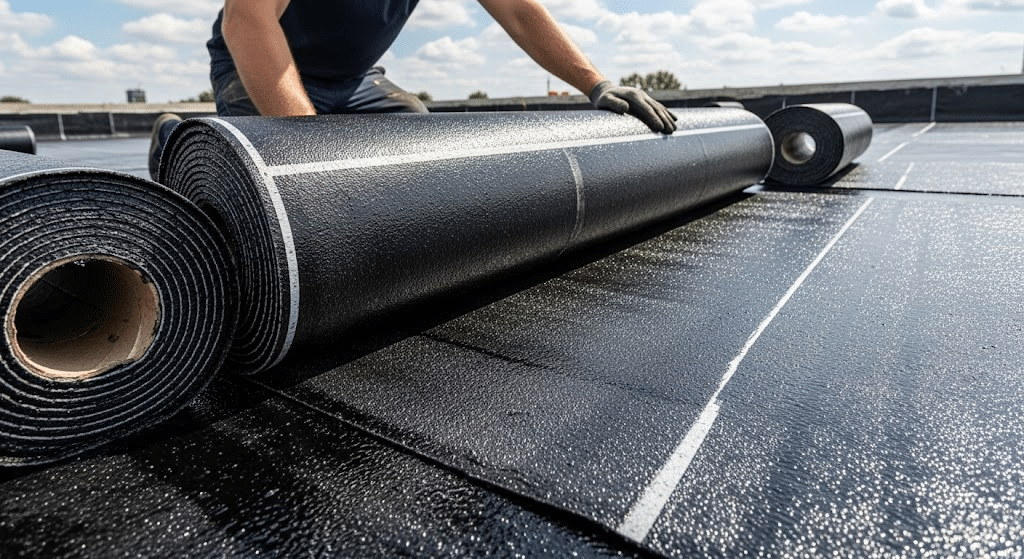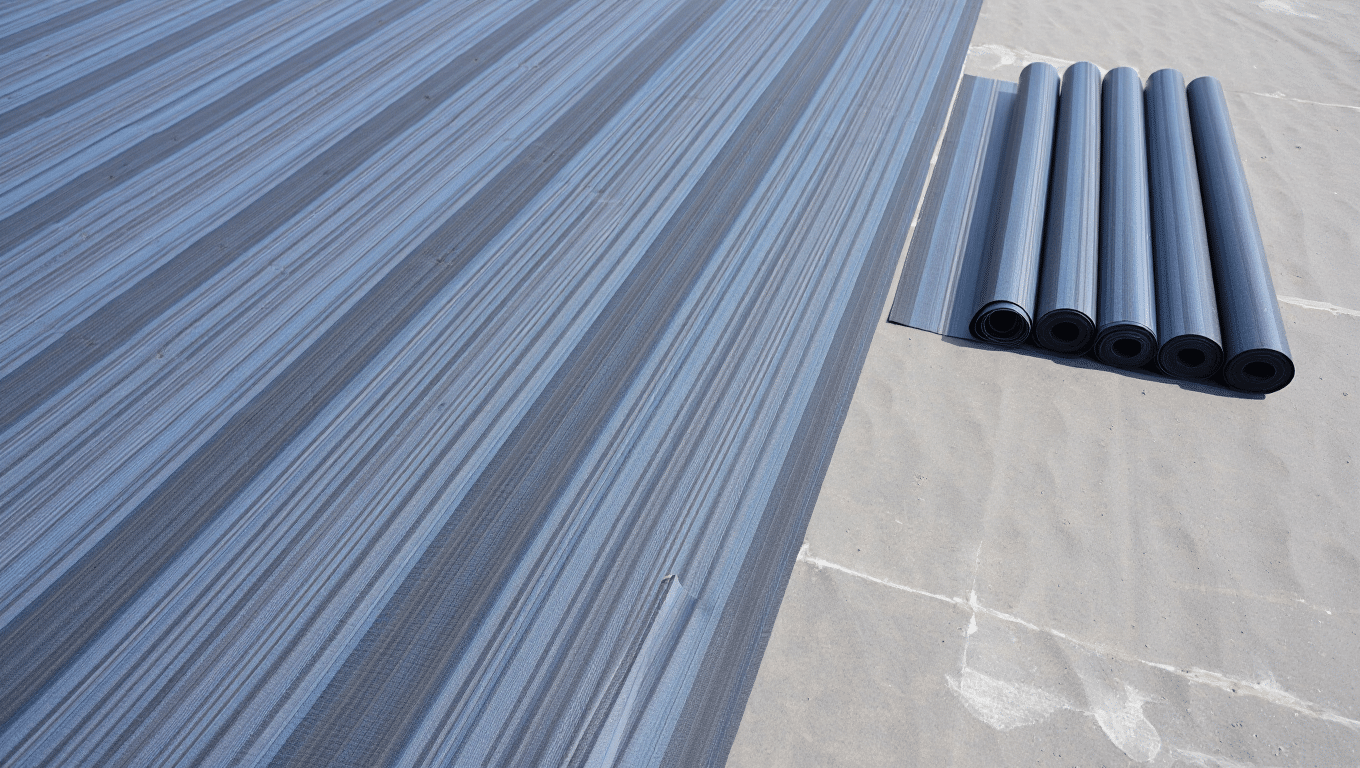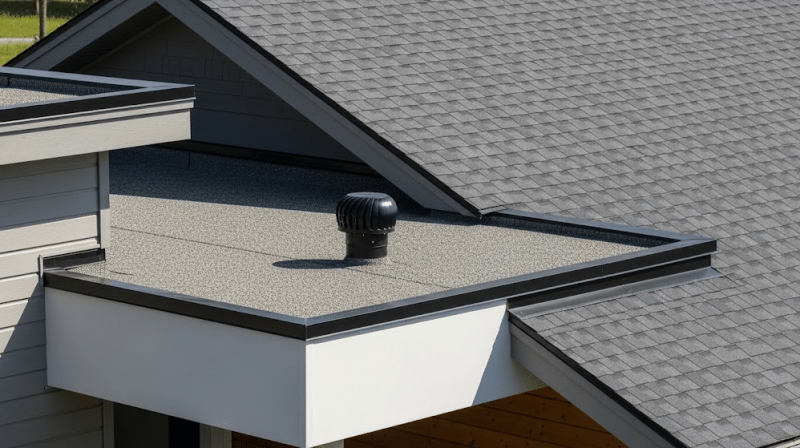Choosing the right roofing material can feel overwhelming. You’re stuck between modified bitumen vs roll roofing, and both seem similar at first glance.
Making the wrong choice means wasted money and future headaches.
I’ll help you pick the perfect option for your specific needs. Modified bitumen offers durability but costs more upfront. Roll roofing is budget-friendly but has a shorter lifespan.
This guide breaks down the key differences between these materials, covers the pros and cons of each, plus shows you exactly when to choose one over the other. By the end, you’ll know which roofing solution fits your budget and requirements.
What is Roll roofing and Modified Bitumen?
Before I compare these materials, you need to understand what they actually are.
Let me break down the basics of roll roofing and modified bitumen so you can make sense of the differences.
Roll roofing is exactly what it sounds like – roofing material that comes in rolls. I often see it made with asphalt-saturated felt topped with mineral granules. It’s a single-layer system that’s pretty straightforward.
You’ll find roll roofing on sheds, garages, and low-sloped residential roofs. It works well for structures that don’t need premium looks. The installation is simple – you roll it out, overlap the seams, and nail it down. That’s why many DIY homeowners choose it.
Modified bitumen takes regular asphalt and adds rubber or plastic polymers. This makes it more flexible and durable than standard roofing materials.
I see two main types: torch-down and peel-and-stick. Torch-down requires heat application, while peel-and-stick has adhesive backing.
Most commercial buildings and flat roofs use modified bitumen because it handles weather changes better than roll roofing.
Key Differences Between Modified Bitumen and Roll Roofing

Now that you know what each material is, let’s compare modified bitumen vs roll roofing directly. I’ll break down the key differences that matter most for your roofing decision.
Installation Process: Which Is Easier and Safer?
Roll roofing wins hands down for DIY projects. I can install it with basic tools – hammer, nails, and a utility knife. You don’t need special equipment or extensive training.
Modified bitumen is trickier. Torch-down types require propane torches, which means fire risk. I always recommend hiring professionals for this.
Peel-and-stick versions are safer but still need proper surface prep and technique.
Durability and Lifespan
Here’s where modified bitumen shines. It flexes with temperature changes and resists cracking better. I’ve seen it last 15-20 years in harsh climates.
Roll roofing typically lasts 5-10 years. It gets brittle in extreme heat and cold. The seams are also weak spots where water can sneak in.
Cost Comparison
Roll roofing costs less upfront, about $1-2 per square foot. Modified bitumen runs $3-5 per square foot.
But here’s the catch: you’ll replace roll roofing twice in the time modified bitumen lasts. Labor costs vary, too. Roll roofing installation is cheaper since it’s faster and simpler.
Aesthetics and Functionality
Roll roofing looks basic. It’s functional but won’t win any beauty contests. Modified bitumen offers better finishes and color options.
For performance, modified bitumen handles ponding water better. It also resists UV damage and foot traffic more effectively than roll roofing.
Maintenance and Repair Needs
Roll roofing needs more frequent checks. I recommend inspecting it twice yearly. Repairs are easy, but happen more often.
Modified bitumen requires less maintenance overall. When problems occur, repairs can be more complex and costly. But you’ll deal with issues less frequently.
Advantages and Disadvantages at a Glance
I’ve put together this comparison table to help you see the key differences clearly:
| Aspect | Modified Bitumen | Roll Roofing |
|---|---|---|
| Pros | Lasts 15-20 years. Handles weather changes well. Resists UV damage. Good for foot traffic. Less maintenance is needed. Handles ponding water |
Budget-friendly upfront. Easy DIY installation. Basic tools required. Quick to install. Simple repairs |
| Cons | Higher initial cost. Needs professional installation. Complex repairs. Requires special tools (torch-down) |
Short lifespan (5-10 years). Gets brittle easily. Weak seams and thus frequent maintenance. Poor water resistance. Basic appearance |
Think about your priorities. Need something cheap and quick? Roll roofing works.
Want something that lasts and performs better? Modified bitumen is worth the extra cost.
How to Decide Which Roofing System Is Right for You?

You’ve seen the main features of modified bitumen vs roll roofing, but which one should you actually choose?
Let me help you match the right roofing material to your specific situation and needs.
Best Fit by Project Type and Budget
I recommend roll roofing for sheds, garages, or quick fixes when money’s tight. It’s perfect for temporary structures or buildings you don’t plan to keep long-term.
Choose modified bitumen for your main house, commercial buildings, or anywhere you need durability. Yes, it costs more upfront, but I’ve seen it save money over time.
Climate and Environmental Factors to Consider
Hot climates beat up roll roofing fast. I’ve watched it crack and curl in intense sun. Heavy snow loads also cause problems with its weaker structure.
Modified bitumen handles extreme weather better. It stays flexible in cold and resists UV damage in hot areas.
Questions to Ask Your Roofing Contractor
Ask these key questions: “What roof slope works best for each material?” “Is my building ready for torch-down installation?” “What warranties come with each option?“
Also, find out about insurance coverage. Some policies favor certain materials over others.
Conclusion
The modified bitumen vs roll roofing debate isn’t about finding a winner. It’s about matching the right material to your specific situation.
Roll roofing works great for budget projects and simple structures. Modified bitumen excels when you need long-term performance and weather resistance.
Your budget, climate, and how long you need the roof to last. Don’t guess on this decision.
Take time to evaluate your specific needs, compare costs over time, and talk to a local roofing professional if you’re unsure. Your roof protects everything underneath it, choose wisely.







